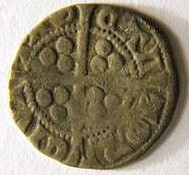
PREV ARTICLE
NEXT ARTICLE
FULL ISSUE
PREV FULL ISSUE
14TH CENTURY SILVER COIN FOUND IN MAINE
An E-Sylum reader forwarded this article from Maine, which describes a recent coin find.
-Editor
"I always see broken shards of pottery along the river," she said. "That day, I was just sitting on a dinghy and staring at the sand, when I saw something that looked like a bit of pottery." She picked it up and thought she had found a small religious medal. "I showed it to my neighbor who's British," Scotland said. "She said it might be a coin." Emerson "Tad" Baker, a professor of history and historical archaeology at Salem State University in Salem, Mass., and a resident of York.... e-mailed images of the coin to Barrie Cook, curator of medieval and early modern coinage at the British Museum in London. Cook responded that while the "image is rather murky," the coin looks, from the shape of the crown, to be a penny of Edward I/II, circa 1305-1310, Canterbury mint. The coin was found on the shoreline amid the remains of a wharf that dates back at least to the mid-19th century — and very possibly back to 1649 — when this land was first granted to three Englishmen, he said. This included the right to build a stage — or wharf — for their fishing operation. Scotland gifted the coin to the Museums of Old York this spring. "It is fun to try and imagine how the coin ended up here," she said. By the mid-17th century, there was a busy working waterfront, where it would have been easy for someone to drop a coin, Baker wrote in his report to the Museums of Old York. "Indeed, the site of the home of one of the three fishermen is only a couple hundred feet away," he wrote. The best alternative to someone dropping an old, but only moderately circulated coin is the possibility the coin arrived with construction material for the wharf, through ship ballast. "Ships often gathered up piles of rock and sand in harbors and deposited them in their holds to make up weight for a light cargo," Baker said. "While it is an unusual find, such isolated early coin finds are not altogether unknown. Indeed, a Roman coin was found many years ago on the coast of Maine. It probably arrived here via ballast."
I like the ballast theory. That can explain a lot of seemingly odd coins that have turned up on these shores. What do readers think?
-Editor
To read the complete article, see:
14th century silver coin found at Cape Neddick River
(www.seacoastonline.com/articles/20120829-NEWS-208290319)
The Numismatic Bibliomania Society is a non-profit organization promoting numismatic literature. See our web site at coinbooks.org. To submit items for publication in The E-Sylum, write to the Editor at this address: whomren@gmail.com To subscribe go to: https://my.binhost.com/lists/listinfo/esylum All Rights Reserved. NBS Home Page Contact the NBS webmaster 
|
